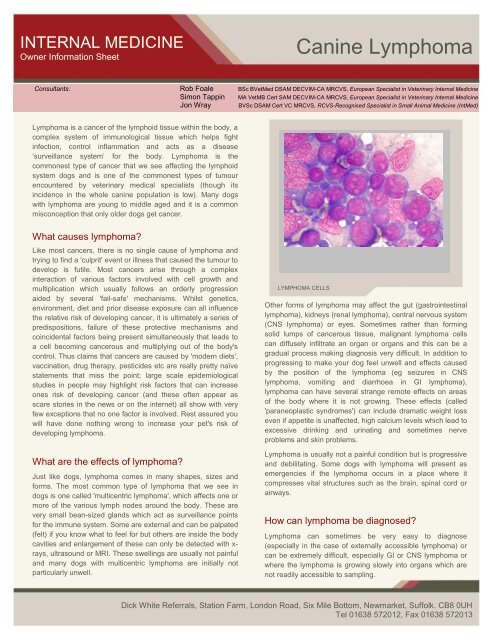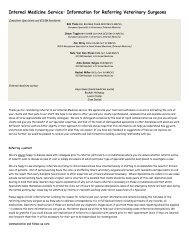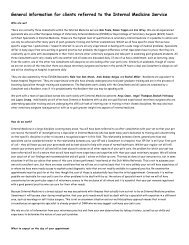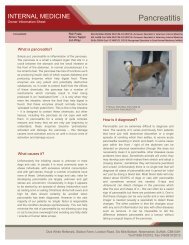Canine Lymphoma - Dick White Referrals
Canine Lymphoma - Dick White Referrals
Canine Lymphoma - Dick White Referrals
Create successful ePaper yourself
Turn your PDF publications into a flip-book with our unique Google optimized e-Paper software.
INTERNAL MEDICINE<br />
Owner Information Sheet<br />
<strong>Canine</strong> <strong>Lymphoma</strong><br />
Consultants: Rob Foale BSc BVetMed DSAM DECVIM-CA MRCVS, European Specialist in Veterinary Internal Medicine<br />
Simon Tappin MA VetMB Cert SAM DECVIM-CA MRCVS, European Specialist in Veterinary Internal Medicine<br />
Jon Wray BVSc DSAM Cert VC MRCVS, RCVS-Recognised Specialist in Small Animal Medicine (IntMed)<br />
<strong>Lymphoma</strong> is a cancer of the lymphoid tissue within the body, a<br />
complex system of immunological tissue which helps fight<br />
infection, control inflammation and acts as a disease<br />
„surveillance system‟ for the body. <strong>Lymphoma</strong> is the<br />
commonest type of cancer that we see affecting the lymphoid<br />
system dogs and is one of the commonest types of tumour<br />
encountered by veterinary medical specialists (though its<br />
incidence in the whole canine population is low). Many dogs<br />
with lymphoma are young to middle aged and it is a common<br />
misconception that only older dogs get cancer.<br />
What causes lymphoma<br />
Like most cancers, there is no single cause of lymphoma and<br />
trying to find a 'culprit' event or illness that caused the tumour to<br />
develop is futile. Most cancers arise through a complex<br />
interaction of various factors involved with cell growth and<br />
multiplication which usually follows an orderly progression<br />
aided by several 'fail-safe' mechanisms. Whilst genetics,<br />
environment, diet and prior disease exposure can all influence<br />
the relative risk of developing cancer, it is ultimately a series of<br />
predispositions, failure of these protective mechanisms and<br />
coincidental factors being present simultaneously that leads to<br />
a cell becoming cancerous and multiplying out of the body's<br />
control. Thus claims that cancers are caused by 'modern diets',<br />
vaccination, drug therapy, pesticides etc are really pretty naïve<br />
statements that miss the point; large scale epidemiological<br />
studies in people may highlight risk factors that can increase<br />
ones risk of developing cancer (and these often appear as<br />
scare stories in the news or on the internet) all show with very<br />
few exceptions that no one factor is involved. Rest assured you<br />
will have done nothing wrong to increase your pet's risk of<br />
developing lymphoma.<br />
What are the effects of lymphoma<br />
Just like dogs, lymphoma comes in many shapes, sizes and<br />
forms. The most common type of lymphoma that we see in<br />
dogs is one called 'multicentric lymphoma', which affects one or<br />
more of the various lymph nodes around the body. These are<br />
very small bean-sized glands which act as surveillance points<br />
for the immune system. Some are external and can be palpated<br />
(felt) if you know what to feel for but others are inside the body<br />
cavities and enlargement of these can only be detected with x-<br />
rays, ultrasound or MRI. These swellings are usually not painful<br />
and many dogs with multicentric lymphoma are initially not<br />
particularly unwell.<br />
LYMPHOMA CELLS<br />
Other forms of lymphoma may affect the gut (gastrointestinal<br />
lymphoma), kidneys (renal lymphoma), central nervous system<br />
(CNS lymphoma) or eyes. Sometimes rather than forming<br />
solid lumps of cancerous tissue, malignant lymphoma cells<br />
can diffusely infiltrate an organ or organs and this can be a<br />
gradual process making diagnosis very difficult. In addition to<br />
progressing to make your dog feel unwell and effects caused<br />
by the position of the lymphoma (eg seizures in CNS<br />
lymphoma, vomiting and diarrhoea in GI lymphoma),<br />
lymphoma can have several strange remote effects on areas<br />
of the body where it is not growing. These effects (called<br />
'paraneoplastic syndromes') can include dramatic weight loss<br />
even if appetite is unaffected, high calcium levels which lead to<br />
excessive drinking and urinating and sometimes nerve<br />
problems and skin problems.<br />
<strong>Lymphoma</strong> is usually not a painful condition but is progressive<br />
and debilitating. Some dogs with lymphoma will present as<br />
emergencies if the lymphoma occurs in a place where it<br />
compresses vital structures such as the brain, spinal cord or<br />
airways.<br />
How can lymphoma be diagnosed<br />
<strong>Lymphoma</strong> can sometimes be very easy to diagnose<br />
(especially in the case of externally accessible lymphoma) or<br />
can be extremely difficult, especially GI or CNS lymphoma or<br />
where the lymphoma is growing slowly into organs which are<br />
not readily accessible to sampling.<br />
<strong>Dick</strong> <strong>White</strong> <strong>Referrals</strong>, Station Farm, London Road, Six Mile Bottom, Newmarket, Suffolk. CB8 0UH<br />
Tel 01638 572012, Fax 01638 572013
<strong>Canine</strong> <strong>Lymphoma</strong><br />
INTERNAL MEDICINE<br />
All lymphomas can only be truly diagnosed with a tissue biopsy<br />
examined by a veterinary pathologist and this may require<br />
surgery (or even multiple surgeries) to be certain. In addition,<br />
because the implications of lymphoma is that several areas of<br />
the body may be affected and we need to be sure of knowing<br />
the extent of the disease and the effects on other organs, we<br />
usually have to do a series of blood tests and imaging<br />
procedures (usually x-rays and ultrasound) and often bone<br />
marrow evaluation. This process called 'staging' the tumour<br />
allows us to gauge the extent of the disease which is important<br />
in making treatment decisions (the same treatment is not<br />
appropriate for all forms of lymphoma) and to give you an idea<br />
of prognosis. Sometimes special pathology tests such as<br />
„immunohistochemistry‟ may be recommended to distinguish<br />
between the T and B-cell subtypes. There is no „blood test‟ for<br />
lymphoma though there are some features which can be seen<br />
on specialized blood tests which can make lymphoma more or<br />
less likely<br />
Chemotherapy is a very emotive word as most people<br />
associate chemotherapy with the side-effects experienced by<br />
most people receiving anti-cancer drugs. However, whilst in<br />
people the intent of treatment is always to cure the disease<br />
(meaning that powerful<br />
Chemotherapy<br />
being given to a dog<br />
through an<br />
intravenous cannula<br />
placed in the right<br />
foreleg. It is<br />
important that<br />
chemotherapy<br />
drugs are<br />
administered<br />
carefully in this way<br />
Can lymphoma be treated<br />
<strong>Lymphoma</strong> is usually ultimately a fatal disease though it is one<br />
of the few cancers which we can readily treat to make dogs feel<br />
substantially better. Treatment will, in most cases, make the<br />
disease go into remission (ie make the clinical signs disappear)<br />
but this is unfortunately not the same as a cure as most dogs<br />
will eventually relapse and their tumour will come back. Thus it<br />
should be remembered that when we treat lymphoma we are<br />
unlikely to cure it and ultimately the affected dog will still be<br />
expected to succumb to the disease. Very occasionally we see<br />
such long-lasting remissions that effectively the patient is cured<br />
but this probably occurs in less than 10% of cases.<br />
CHEMOTHERAPY<br />
Untreated lymphoma usually progresses to such an extent that<br />
euthanasia is requested on humane grounds within in 4-8<br />
weeks of the clinical signs starting. Treatment of lymphoma<br />
involves giving drugs to kill the tumour cells (chemotherapy).<br />
“the goal of chemotherapy is to promote<br />
quality of life…The overwhelming<br />
majority of dogs treated for lymphoma do<br />
not show side effects ”<br />
Two of our dedicated medicine nurses administering<br />
chemotherapy to a regular patient. Dogs are very tolerant of<br />
chemotherapy and when we see them regularly become part of<br />
„gang‟. Our medicine nurses regularly admit and discuss any<br />
concerns with owners and are an important part of our team<br />
approach to cancer patients<br />
CHEMOTHERAPY<br />
<strong>Dick</strong> <strong>White</strong> <strong>Referrals</strong>, Station Farm, London Road, Six Mile Bottom, Newmarket, Suffolk. CB8 0UH<br />
Tel 01638 572012, Fax 01638 572013
<strong>Canine</strong> <strong>Lymphoma</strong><br />
INTERNAL MEDICINE<br />
I am considering treatment; what factors should I<br />
take into consideration<br />
First some facts. As already stated dogs with lymphoma live an<br />
average of 4-8 weeks before becoming so ill that euthanasia is<br />
requested. If you do not elect to proceed with chemotherapy<br />
then palliative therapy with corticosteroids can be given and<br />
this will not increase life expectancy but generally makes dogs<br />
'feel' better.<br />
Chemotherapy drugs are mostly given by injection via an<br />
intravenous cannula on an outpatient basis. These agents<br />
need to be very carefully handled and blood tests are<br />
needed before each administration.<br />
CHEMOTHERAPY<br />
cocktails of drugs with increased risk of side effects are the<br />
norm and are tolerated by cancer patients), in our veterinary<br />
patients we do not feel it ethical to treat if the treatment makes<br />
the animal feel worse. We cannot explain to our patients that a<br />
cure may be possible by experiencing short-term side effects<br />
and so our aim is different – we want to make our patients feel<br />
better (preferably completely normal) for as long as possible<br />
and to experience good quality of life . This means that we<br />
seldom cure the disease but hopefully we don't make them feel<br />
bad either. Side effects in animals on chemotherapy that we<br />
use are therefore rare (see separate information) and if we feel<br />
that side effects are unacceptable we stop the treatment.<br />
The decision to treat lymphoma can be an extremely difficult<br />
one and it should be borne in mind that treatment of lymphoma<br />
is an extremely large commitment in terms of emotion, time<br />
(weekly visits to a vet or veterinary specialist are usually<br />
needed and these need to be at strict times) and money<br />
(treatment costs frequently add up to many hundreds or even<br />
thousands of pounds over a period of months).<br />
Not all pet owners wish to pursue chemotherapy and not all<br />
patients are suitable candidates for treatment and in many<br />
cases humane euthanasia may be the kindest option. There is<br />
absolutely nothing wrong with making the decision for a pet to<br />
be humanely put to sleep rather than suffer form a cancerous<br />
disease and it is kinder for the pet to take this course of action<br />
than to embark upon treatment which you do not wish to or<br />
cannot for practical reasons pursue.<br />
With some exceptions about 75-90% of dogs with lymphoma<br />
will go into remission when treated with chemotherapy (less<br />
likely with T-cell types of lymphoma). The remainder either do<br />
not respond at all or respond partially and temporarily. Of the<br />
dogs who respond the average length of their remission is in<br />
the region of 6-12 months. Most dogs will then relapse and the<br />
decision is usually made at that time either to perform humane<br />
euthanasia, or to try another chemotherapy treatment. On<br />
average treated dogs who respond will be expected to live for<br />
about a year with good quality of life. A small proportion of<br />
dogs that undergo chemotherapy will have very lengthy<br />
remissions from their illness which may last 2 years or more.<br />
Treatment usually involves using a combination of drugs (most<br />
of these work better in combination than alone) called a<br />
'chemotherapy protocol'. There are many types of protocol<br />
used for dogs with lymphoma and all have similar success<br />
rates, some slightly more than others. We therefore take into<br />
consideration things like the type of tumour, the frequency of<br />
monitoring and hospital visits needed, the cost of the drug<br />
therapy and working schedule of the dog's owners. The drugs<br />
are usually given in a specific timetable and either continued<br />
until the lymphoma relapses or given for a fixed period of time<br />
and then stopped (this depends on the type of protocol used).<br />
There are certain features that we know will make the chances<br />
of chemotherapy working in a dog a lot lower. These include –<br />
having high levels of calcium in the blood, having involvement<br />
of the bone marrow, having lymphoma of the gastrointestinal<br />
tract, kidneys or central nervous system, and having lymphoma<br />
which has been previously treated for instance with<br />
corticosteroids. These factors all have to be taken into account<br />
when you are deciding whether to go ahead with treatment and<br />
which is why we try and get as much information as possible<br />
before starting treatment.<br />
With chemotherapy protocols there are some pros and cons of<br />
different types of protocol which need to be balanced. We<br />
know that in general, the chances of attaining the longestlasting<br />
remission possible is seen with protocols that contain a<br />
type of drug called doxorubicin (sometimes a drug called<br />
<strong>Dick</strong> <strong>White</strong> <strong>Referrals</strong>, Station Farm, London Road, Six Mile Bottom, Newmarket, Suffolk. CB8 0UH<br />
Tel 01638 572012, Fax 01638 572013
<strong>Canine</strong> <strong>Lymphoma</strong><br />
INTERNAL MEDICINE<br />
Delete this box or enter quote or tagline here.<br />
Some definitions<br />
Remission<br />
Successful eradication of identifiable lymphoma<br />
Induction therapy<br />
Chemotherapy given to initially put the tumour into remission<br />
Chemotherapy protocol<br />
A protocol is a combination of chemotherapy drugs where the<br />
combination works more effectively than the individual drugs<br />
separately<br />
Continuous / discontinuous therapy<br />
A dog with lymphoma causing enlargement of the lymph<br />
nodes under the angle of the jaw which can be seen to be<br />
enlarged (arrows)<br />
epirubicin is used instead). These protocols often require access to<br />
specialised handling facilities (as these drugs are very hazardous<br />
to veterinary personnel preparing them) and necessitate some<br />
special monitoring for toxicity to the heart. For this reason these<br />
protocols have an increased chance of success but are also more<br />
costly, involve more frequent travel to a veterinary specialist centre.<br />
Other protocols do not have these drawbacks, but similarly do not<br />
have quite the same degree of success. Additionally veterinary<br />
practices vary greatly in how experienced they are in handling<br />
chemotherapy drugs. Administration of these products is<br />
hazardous to veterinary personnel and in practices where the<br />
number of cancer patients seen is low, chemotherapy may not be<br />
available<br />
We will generally, when deciding what sort of chemotherapy to use,<br />
take into account your own practical wishes, costs, your willingness<br />
to travel, the availability at your vet of chemotherapy, the type of<br />
lymphoma and the temperament of your dog. We aim to then reach<br />
a consensus of what the most practical and effective treatment is<br />
likely to be. Remember that the important thing is that any regime<br />
embarked upon is practical for you and your dog rather than<br />
necessarily the one that yields marginally better results than<br />
others.<br />
What happens if lymphoma recurs<br />
If the lymphoma recurs then either a type of rescue chemotherapy<br />
can be tried or euthanasia may be considered. The chances of<br />
subsequent chemotherapy achieving remission, and if successful,<br />
the duration of that remission, gets much poorer with each relapse.<br />
In the past much chemotherapy was given continuously with<br />
a gradually increasing interval between doses. Many newer<br />
regimes involve chemotherapy being discontinued after the<br />
induction course. This does not result in higher risk of<br />
relapse.<br />
Relapse<br />
Rescue<br />
Recurrence of the lymphoma<br />
Chemotherapy treatment given to treat relapse<br />
KEY POINTS about <strong>Canine</strong> <strong>Lymphoma</strong><br />
Chemotherapy is the mainstay of therapy.<br />
Quality of life is as important as keeping the<br />
disease in remission<br />
Side effects are very rarely seen but it is<br />
important that regular blood tests are taken<br />
to „pre-empt‟ problems so that they can be<br />
avoided<br />
Chemotherapy is a large commitment in<br />
terms of time, emotion and finance<br />
Dogs that are in remission from lymphoma<br />
will act normally and be free of signs of their<br />
disease<br />
<strong>Dick</strong> <strong>White</strong> <strong>Referrals</strong>, Station Farm, London Road, Six Mile Bottom, Newmarket, Suffolk. CB8 0UH<br />
Tel 01638 572012, Fax 01638 572013








